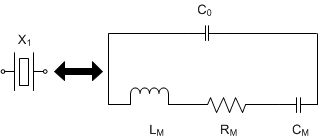SWRA495K December 2015 – April 2024 CC1310 , CC1350 , CC2620 , CC2630 , CC2640 , CC2640R2F , CC2640R2F-Q1 , CC2642R-Q1 , CC2650 , CC2662R-Q1
- 1
- Abstract
- Trademarks
- 1Oscillator and Crystal Basics
- 2Overview of Crystal Oscillators for CC devices
- 3Selecting Crystals for the CC devices
- 4PCB Layout of the Crystal
- 5Measuring the Amplitude of the Oscillations of Your Crystal
- 6Crystals for CC13xx, CC26xx and CC23xx
- 7High Performance BAW Oscillator
- 8References
- 9Revision History
1.2 Quartz Crystal Electrical Model
A quartz crystal is a piezoelectric device that transforms electric energy to mechanical energy. This transformation occurs at the resonant frequency. Figure 1-2 shows the simplified electric model that describes the quartz crystal, where C0 is the shunt capacitance, LM is motional inductance, CM is motional capacitance, and RM is motional resistance. The model in Figure 1-2 is a simplified model and includes only the fundamental oscillation frequency. In reality, crystals can also oscillate at odd harmonics of the fundamental frequency.
 Figure 1-2 Crystal
Symbol and the Electrical Model of a Quartz Crystal
Figure 1-2 Crystal
Symbol and the Electrical Model of a Quartz Crystal